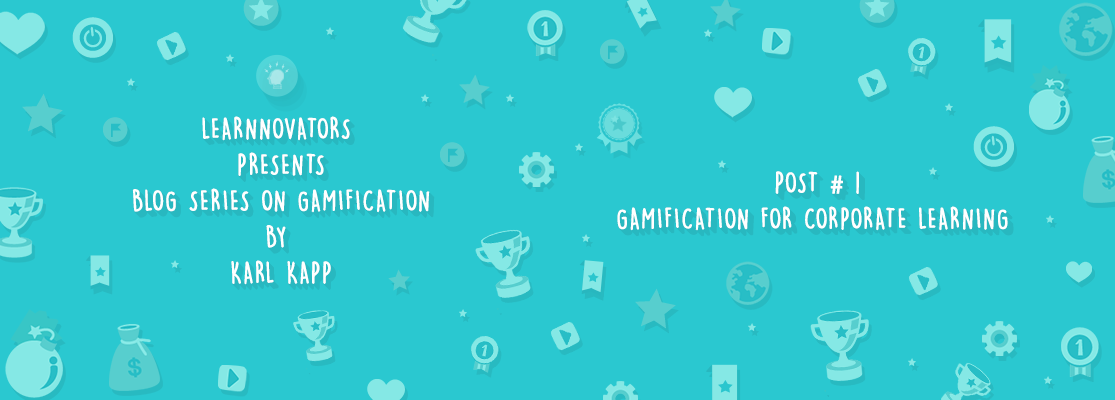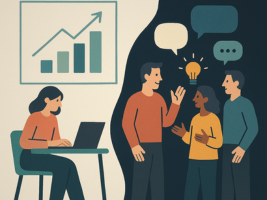GAMIFICATION FOR CORPORATE LEARNING
This is the first in a series of articles about gamification written by Karl Kapp exclusively for Learnnovators. The series starts with a definition of gamification, and further defines two types of gamification. Then it discusses the engagement aspects of gamification, the possibilities of gamification, and some mistakes often made by organizations attempting gamification for the first time.
To understand the potential impact of gamification on the learning and development side of an organization, it’s important to establish some definitions. A common language is key to conveying to heads of business units and others how you would like to leverage gamification for learner success.
First, let’s look at the definition. For our purposes, the term “gamification” captures the idea that elements of games can be infused into instructional situations within corporate and government environments to provide a positive learning outcome without having to create a full blown learning game.
Gamification has been defined as the “process of using game thinking and mechanics to engage audiences and solve problems” (Zichermann, 2010), “using game techniques to make activities more engaging and fun” (Kim, 2011), and “the use of game design elements in non-game contexts” (Deterding et al., 2011, p. 1). From an instructional context, the most relevant definition is one that combines elements from these definitions and defines gamification as “using game-based mechanics, aesthetics and game thinking to engage people, motivate action, promote learning, and solve problems” (Kapp, 2012, p. 10).
“Gamification” is a broad term that can be further refined into two types, structural gamification and content gamification.
STRUCTURAL GAMIFICATION
“Structural gamification is the application of game-elements to propel a learner through content with no alteration or changes to the content” (Kapp, Blair, & Mesch, 2013, p. 224). The content does not become game-like; only the structure around the content does. A common implementation of this type of gamification adopts the scoring elements of video games, such as points, levels, badges, leaderboards, and achievements, and applies them to an educational context (Nicholson, 2012).
Structural gamification’s continual, real-time assessment of progress provides important information to both the learners within the organization and the trainers or supervisors as learners complete portions of content, take quizzes to gauge knowledge acquisition, and move toward prescribed training goals. The continual assessment of progress helps identify strengths and weaknesses.
For example, a corporation employs structural gamification when a learner is assigned content to be learned through a daily quiz-type game for two weeks via email or a mobile app. If the learner answers correctly, they earn points and progress toward earning a digital badge. If the learner answers incorrectly, they are immediately presented with a short instructional piece specifically addressing the question’s topic. Questions are repeated at various intervals until the employee demonstrates mastery of the topic. The quiz and instruction process takes 30 to 90 seconds each day, at either the beginning of the day or the end of the day, based on the employee’s or employer’s decision.
As the employee progresses through the content, the number of questions they have answered correctly is indicated on a leaderboard for the entire company or division to view, enabling them to assess their progress relative to other individuals, or an overall team-based score is made available.
CONTENT GAMIFICATION
“Content gamification is the application of game elements, game mechanics and game thinking to alter content to make it more game-like” (Kapp et al., 2013, p. 237). A common implementation of this type of gamification adds elements, such as story, mystery, and characters, to content to engage the learner. For example, content gamification can be realized by embedding a series of accounting terms and problem into a fantasy narrative or by starting a dialogue with a verbal challenge such as “what do you do if you suspect your manager of embezzling money” instead of a list of objectives.
LEVERAGING TECHNOLOGY FOR GAMIFICATION
The fundamental elements of the two types of gamification, structural or content, are not new to instruction. For example, learners commonly earn “points” for correctly answering a multiple choice compliance test correctly or need to obtain a certain score on a quiz before they can earn a certificate for the e-learning module. While not traditionally called “gamification,” the exchange of performance for points, a certificate or an award can certainly be classified as a game-like element. Points are not a “natural” part of learning; they are added to the learning of compliance concepts as a method of motivation and assessment. Points are used to measure learner progress in e-learning and compliance assessments, just as points are used to measure progress in games. Similarly, challenges, stories, and mysteries are routinely used by many trainers and instructional designers to engage learners and provoke their thinking.
What is new is technology’s capability to expand and enhance gamification, especially to personalize and track individual learner performance and to provide immediate, actionable feedback. Technology can present students with an immediate response to a question or inquiry, and can provide teachers with data useful in diagnosing student progress. Technology also allows multiple attempts at learning without the social stigma of failure because gamification can be experienced one-on-one between the learning and the gamified environment (if a leaderboard is not present).
A well designed gamification experience can even provide hints, and eventually answers, providing appropriate scaffolding so failure is temporary and fleeting. Gamification can be personalized, so that learners compete against the computer or themselves rather than against fellow employees. When designed properly, “gamification can shorten feedback cycles, give learners low-stakes ways to assess their own capabilities.” (Lee & Hammer, 2011, pp. 3–4).
CONCLUSION
Gamification is in its infancy as far as its use within organizations is concerned. The application and use of the concepts of gamification is still relatively new, but already forward thinking organizations are reaping the benefits of both structural and content gamification. Understanding the various types of gamification and the role that technology plays in a successful gamification implementation can go a long way toward helping an organization leverage the benefits of gamification for increased learning and productivity.
REFERENCES
Deterding, S., Khaled, R., Nacke, L. E., & Dixon, D. (2011, May). Gamification: Toward a definition. In Proceedings of CHI 2011 Gamification Workshop, (pp. 1-4). Vancouver, BC, Canada.
Kapp, K. M. (2012). The gamification of learning and instruction: Case-based methods and strategies for training and education. New York, NY: Pfeiffer.
Kapp, K. M., Blair, L., &Mesch, R. (2013). The gamification of learning and instruction fieldbook: Theory into practice. New York, NY: John Wiley & Sons.
Kim, A. J. (2011, March 23). Gamification 101: Designing the player journey . Retrieved from Smart Gamification: Designing the Player Journey.
Lee, J. J., & Hammer, J. (2011). Gamification in education: What, how, why bother? Academic Exchange Quarterly,15(2), 1.
Nicholson, S. (2012, June). A user-centered theoretical framework for meaningful gamification. Paper presented at Games+Learning+Society 8.0, Madison, WI.
Zichermann, G. (2010, October 26). Fun is the future: Mastering gamification . Retrieved from Fun is the Future: Mastering Gamification.Here are links to all five posts from this series:
1. Gamification For Corporate Learning
2. Avoid These Gamification Pitfalls
3. The Learning In Gamification
4. Gamification Is About Engagement
5. The Big Miss And The Big Opportunity In Gamification
Written by Karl Kapp
_________________________________
Published on 31-Aug-2016






